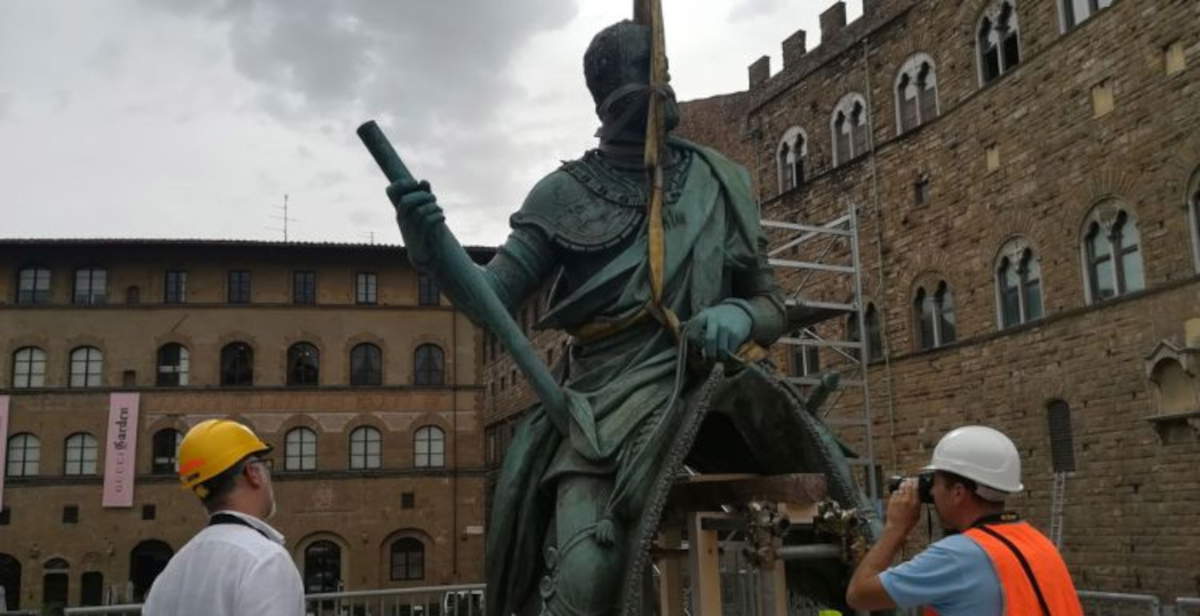In Florence, it is well known, art is not only enclosed in museums: it is an integral part of the city’s squares, streets and vistas. Some of the best-known, world-recognized works can be found outdoors, exposed to the elements and weather. And just to preserve the heritage, the city concluded in January 2025 the restoration of the sculptural groups in Piazza della Signoria and Piazzale Michelangelo, made possible thanks to theArt Bonus and the support of the maison Salvatore Ferragamo S.p.A., in agreement with the City of Florence, with a total funding of 1,093,750 euros. The liberal donations were divided into three tranches: 500,000, 300,000 and 293,750 euros, for a total of 1,093,750 euros. The restoration project, prepared by the Fine Arts Service of the Palazzo Vecchio’s Technical Services Department, allowed continuity to a well-established relationship between the city administration and one of the leading local patrons.
The project began with the restoration of the MichelangeloMonument, consisting of the bronze copy of the David, the four Allegories of the Medici Chapels in San Lorenzo, also in bronze, and the marble base. The work, placed on the panoramic terrace designed by Giuseppe Poggi in the second half of the 19th century, had never before undergone structural intervention on this scale. In fact, for the first time, in addition to cleaning and consolidation operations, an endoscopic survey was carried out to verify the internal conditions of the sculptures with the aim of preserving their long-term integrity. At the same time, the program also involved the sculptures placed in Piazza della Signoria. Here, the equestrian statue of Cosimo I de’ Medici made by Giambologna, the group of Hercules and Cacus sculpted by Baccio Bandinelli, the copy of Michelangelo’s David placed at the entrance to Palazzo Vecchio and the copy of Judith and Holofernes placed on the Arengario of the same palace underwent restoration.

The fountains, once functional for water supply, are now an integral part of the city’s visual identity, while the statues, distributed in squares and streets, tell more than seven centuries of artistic history, from Michelangelo to Ammannati. To ensure the protection of the heritage, the administration has initiated several rounds of extraordinary maintenance over the years:
City Fountains, extraordinary maintenance work on the electrical and water supply control systems byAssociazione Silvana at a cost of 19,346 euros, covered in full by disbursements of the same amount.
Nicola Demidoff Sculpture Group, intervention worth 6,684.79 euros, with expenses incurred of 5,611.80 euros.
Fountain of San Niccolò, restoration of the upper basin, carried out in 2018 at a cost of 2,000 euros, fully funded by a non-commercial entity.
Fountains of San Niccolò, work with open collection started in 2019, with a total value of 110,000 euros. Liberal donations recorded so far amount to 400 euros and 100 euros, both from private donors.

A distinctive aspect of the restoration work on the sculptural groups was the site-as-event model, proposed by the firm that had already been tried out in previous restorations such as that of the Ammannati Fountain and the Sala degli Elementi in Palazzo Vecchio. The goal of the system was thus to ensure maximum enjoyment of the works even during the works, transforming the construction site into an opportunity for encounters and knowledge. In the case of the Michelangelo Monument, the project allowed citizens and tourists to admire the restorers at work on the panoramic terrace, without interrupting the visibility of the monument. In contrast, the work on the sculptural groups in Piazza della Signoria, which started in January 2022, followed an interactive approach: the construction sites were accessible to the public via internal paths and ramps that allowed a close-up and elevated view of the works. The solution also had an inclusive value, allowing architectural barriers to be overcome and offering all visitors a privileged vantage point. The sculptures were surrounded by service structures designed not to obstruct the view of the work in progress, but lighting also played an important role in enhancing the site: the load-bearing structures housed RGB technology fixtures, capable of varying color according to events, creating lighting scenes in the evening hours.
With the return of the restored works, Florence confirms its strategy of protecting its historical and artistic heritage, focusing on high-level technical interventions and the involvement of private patrons. A model that also strengthens the link between the city and its monuments, keeping alive the image of Florence as an open-air museum of global significance.
 |
| Florence, how the Art Bonus supported the restoration of the sculptural groups in Piazza della Signoria |
Warning: the translation into English of the original Italian article was created using automatic tools. We undertake to review all articles, but we do not guarantee the total absence of inaccuracies in the translation due to the program. You can find the original by clicking on the ITA button. If you find any mistake,please contact us.